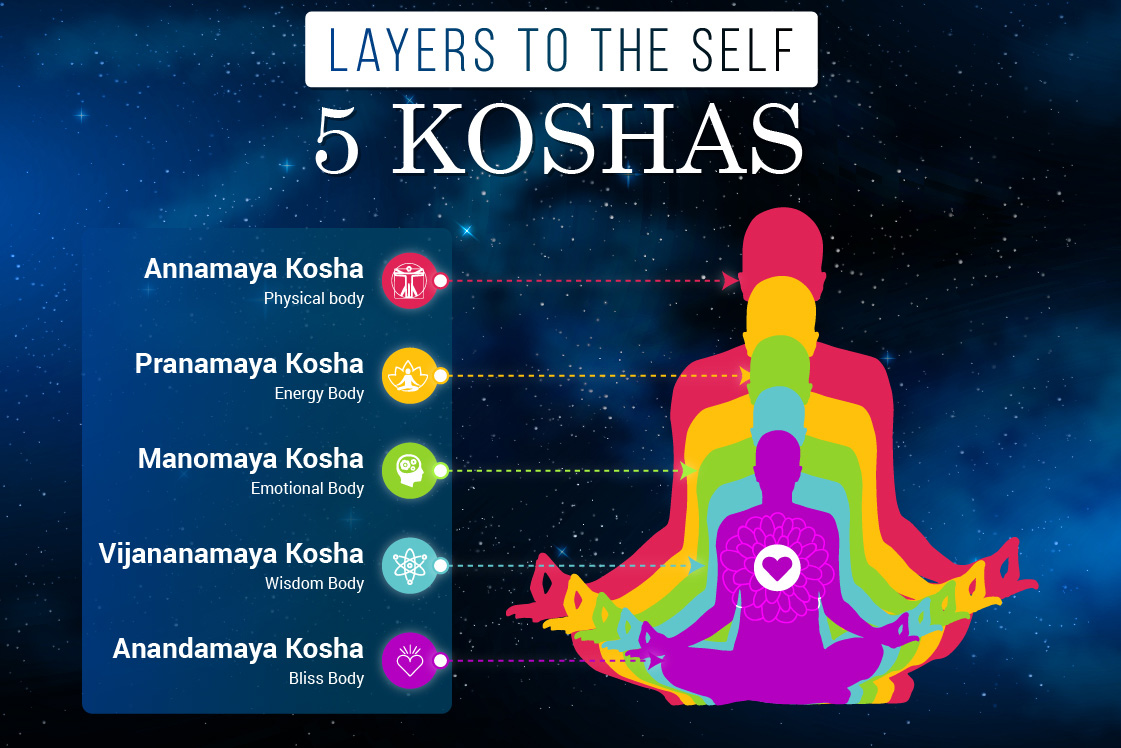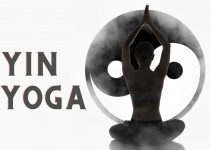
Have you ever imagined how so-called subtle body looks like and why it’s different from the causal body?
Well, the body, whether it’s subtle or gross is a manifestation of energy and, energy can only be experienced through the flow of consciousness.
Consciousness in humans flows in 5 layers of the body to reach the Atman (or Self, according to Vedanta philosophy). These 5 layers in yogic tradition are called koshas.
Understanding the Koshas becomes easier when one is aware of the concept of self (The innermost entity after transcending 5 koshas). So, let’s understand concept of self, first.
Introduction to self or Atman
Self or Atman is the Divine within each being & is beyond 3 Gunas (Sattva, Rajas, & Tamas) as it has no origin and end. Its main characteristics are vigilance and support to everything with any detachment.
In Upanishads, Atman is the subject which persists throughout the changes, the common factor in the states of waking, dream, sleep, death, rebirth, and final deliverance.
References from Upanishads about Atman
Following Upanishads have defined Atman in different verses.
- Kathopanishad defines Atman as the subtler than the subtlest and greater than the greatest, which is seated in the heart of each living being.
Anoraniyan mahato mahiyan Atmasya jantornihito guhayam (Katho.I-ii-20).
It describes Atman as the eternal factor in the body.
- Mandukya Upanishad says Brahman is the Atman and the Atman is the Brahman.
Ayam Atma Brahma (Mandukya )
This Sanskrit verse states that the Supreme power through which all things have been brought into being is one with the in-most Self in each person’s heart.
- Brihadaranyaka Upanishad identifies self with the Purusha which is an all-pervading infinite entity. The Self is different from the intellect, different from the organs.
- Mundaka Upanishad describes the self as ‘self-resplendent, formless, un-originated and pure, that all-pervading Being is both within and without, anterior both to life and mind; He transcends even the transcendent, unmanifested causal state of the universe’.
Nature of Atman
- Chaitanya Svarupah: Nature of Consciousness Itself
- Svatantrah: Independent
- Nirgunah: Non-Material, Attributeless
- Nityah: Ever-existent
- Sarvagatah: All-Pervading
- Ekah: Oneness
Relation Between Koshas & Atman
Kosha is referred to as “sheath”, coverings of the Atman. The Atman or soul resides at the center of the Anandmaya kosha (5th kosha) [Later described in this article].
Atman is distinguishable from the five Koshas, just as the smoke which has its existence through the fire, conceals the fire, the five Koshas which obligate their very existence to the Atman cover the very Atman. The Atman overshadows the koshas.
As in Ayurvedic texts, there are two kinds of relationship,
- Samavaya relation – Inseparable
- Samyoga relation – Separated
Samavaya relation is a concept mentioned in Padarthvigyan (matter science) referring to being inseparable relationship that exists between a person and his qualities or actions. There is no Samavaya relation between Atman and the five Koshas.
Samyoga is the relationship that exists between a drum and the stick. There cannot be any Samyoga relation between Atman and the koshas, as Atman is not a substance that is made up of the five elements.
The relationship between Atman and the koshas is only the Adhyasa (illusory or superimposed).
Human Personality & Concept of Koshas
Guhāhitaṁ Brahma yat tat pañcakośa vivekataḥ, boddhuṁ śakyaṁ tataḥ kośa pañcakaṁ pravi vicyate
Human personality is a combination of physical/mental and spiritual dimensions with the pattern of thoughts, feelings, social adjustments, and behaviors that strongly influences one’s expectations, self-perceptions, values, and attitudes.
Our Upanishads has mentioned that the Purusha exists in terms of 3 bodies (trya-sharira) & 5 sheaths (Pancha-koshas).
Historical Background
- The Taittiriya Upanishad describes human beings to be having a five sheaths personality [Pancha (5) Kosha] comprising of the sharira trya (3 bodies).
- The Triguna Theory: As per the ancient Indian philosophy, personality can be refined with ‘tapas (austerity)’ and value-based education with the concept of 3 gunas (sattva, rajas, tamas) which binds Soul to the World.
- Two Principles of Sankhya Philosophy are Purusha which is Conscious, Intelligent & Inactive & Prakriti which is Unconscious, Non-intelligent & Active, both being interconnected and responsible for the formation of sharira trya (3 Bodies) [Later describing in this article].
- In Ayurvedic text also it can be found that personality is described as 16 types, 7 sattva, 6 rajas and 3 tamas, which are majorly trait characteristics.
Pancha Koshas theory of understanding the personality mentioned in the Taittiriya Upanishad. This is the Vedantic psych philosophical view of human personality and similar to the trait perspective of personality where each Kosha exhibits certain characteristics.
Pancha-kosha: 5 Layers to The Self

In Sanskrit, kosha means “sheath” or “covering.” Koshas can be understood as the layers from which awareness flows from the outer body to inner self & hence, cover the Atman.
Pancha Kosha is the concept in yogic philosophy that there are 5 layers, or sheaths, around the human soul. These 5 layers are also considered the 5 sheaths of human’s personality.
Much like the chakras system in the human body, 5 koshas are located one inside the other with the sheath of the physical body being the outermost and the sheath of bliss being the innermost. Further, these 5 layers are lies in 3 bodies (sharira trya) viz Gross, Subtle and Causal body.
The ancient concept of “Personality” or “Body constitution”, underlines the below mentioned ‘five’ sheaths. They are:
- Annamaya Kosha
- Pranamaya Kosha
- Manomaya Kosha
- Vijananamaya Kosha
- Anandamaya Kosha
1. Annamaya Kosha
‘Annamaya’ [Anna means food and Maya means ‘made of’] is a segment of the human system is nourished by food (anna). Here food represents the ‘Physical matter’ from which the body formation took place (5 elements) and ultimately dissolves into the same (after death). It’s the reason, the first layer of the body is linked with the Root chakra & earth element present in our body.
This sheath contains the 5 elements (earth, space, air, water, fire) that constitute the physical body with a dominance of ‘Tamo guna’. It’s perishable in nature and hence, has a beginning and an end (birth and death).
In yoga, various asanas are helpful to nurture the body and hence the annamaya kosha.
This sheath is the result of the combination of shukla (male seed) and Sonita (female seed) & depends on food because semen is the byproduct of food synthesis only.
Personality or constitution of the individual comprising of physical, mental, social and emotional traits all depend on the condition of annamaya kosha, the formation of which continues in each birth or life one has.
Annamaya kosha relies on shad-bhava-vikara (6 changes) concept viz [efn_note] Kosha and Atman http://sivanandaonline.org/public_html/?cmd=displaysection§ion_id=748 [/efn_note].
- Birth
- Existence
- Growth
- Change
- Decay
- Death
Following methods can be adapted to purify and develop the annamaya kosha:
- Upavas (fasting)
- Asanas (Yogic postures)
- Tatvashudhi (Inner Purification)
- Tapashcharya (Practice of austerity).
- Letting our soul free from worldly attachments from the physical body are the first objective of spirituality. (3)
The first objective of spirituality is freeing the soul from the attachment and identification with the food sheath, Which only can be realized when one is aware of the first sheath completely. All the modern medicines act on this Kosha only.
2. Pranamaya Kosha
‘Pranamaya’ (vital air sheath) segment is nourished by ‘Prana’. This sheath contains the 5 pranas that manifest in the physical body and connecting it to the next kosha i.e. Manomaya kosha.
This sheath has a dominance of Rajo guna, hence subtle activities are normal in this layer. This sheath is also perishable and has a beginning and an end. Prana is the life force that is present in the entire cosmos. It is derived from Moola Prakriti or the Divine Mother.
In yoga, both asanas and pranayama (breathing exercises) affect this kosha.
3. Manomaya Kosha
‘Manomaya’ (mental sheath) is the segment nourished by knowledge.
This sheath contains gyanendriyas & karmendriyas for interaction with the outer world.
- Gyanendriyas are sense organs through which one perceives objects of the world and
- While karmendriyas are organs of actions through which one manipulates with the objects of the world
This kosha is made of a combination of Sattva guna and Tamo guna. It’s also perishable in nature and has a beginning and an end. The Manomaya Kosh comprises mental faculty receiving all the sensory signals, then interpreting them as with positive or negative aspects and at the end aspiring the positive desire.
The primary functions of manomaya kosha are:
- Sankalpas i.e. being the aspects to interpret the intention and act accordingly.
- Vikalpas refers to rejecting undesirable actions mostly with negative outcome.
Our mind is summarised with certain traits referred to as Vrittis, such as lust, anger, greed, etc. Cause of Vrittis, thoughts in mind is continually fluctuating and hence are referred to as Vikari (changing traits). Atman has no scope of any changes or modifications hence is referred to as Nirvikara (changeless).
The mind along with the five sensory organs (taste (tongue), smell (nose), vision (eyes), hearing (ear), and touch (skin), is said to constitute the manomaya kosha or “mind-sheath”.
Various aspects of yoga practice affect this kosha. For example, meditation and alternate nostril breathing can calm the mind.
4. Vijnanamaya Kosha
‘Vijnanamaya’ (intellectual sheath) is nourished by ‘ego’. Vijnana literally means intellect, hence Vijnanamaya kosha is the intellect/wisdom/knowledge sheath. In the chakras system, this kosha is related to the throat chakra & predominant with the air element.
It’s composed of a combination of intellect and the five sensory organs and is also considered to be the part of one’s being that is responsible for will, discernment, and determination.
Buddhi viz intellect with the five organs of knowledge constitutes the Vijnanamaya Kosha or the knowledge-sheath. It’s characterized basically with an involvement with the intelligence when in deep sleep phase, referred to as Chidabhasa [efn_note] Chidabhasa https://en.wikipedia.org/wiki/Chidabhasa[/efn_note].
Vijnanamaya kosha is characterized by being interactive and dependent upon the other sheaths for its existence. In yogic philosophical references, meditation and meditative asanas balance this kosha. In medical treatment aspects, psycho-therapy act on this Kosh precisely.
5. Anandamaya Kosha
Ananda means blissful experience. In Advaita Vedanta, anandamaya kosha is referred to as the innermost Kosha having close proximity with the soul, hence experiences the blissful experience coming out of the soul.
Anandamaya sheath marks the segment which is nourished by emotions and consciousness. This is the intuitive expansive sheath aligned with the causal body and is often thought of as the soul (atman).
The Anandamaya Kosha in its sattvic aspect is the cause of the blissful experience of Sushupti or deep sleep pattern. The ananadamaya kosha highlights the three positive blissful qualities of the Soul viz Sat, Chit and Anand.
- Sat: being truthful and eternal.
- Chit: it refers to the one which is alive and has the consciousness, the main bridging line separating the living and the non-living.
- Anand: it refers to an ever-joyful state.
This sheath refers to the most subtle body which is perceived in bliss. To get it in balanced state, pranayama and meditation practice every day for at least 20 minutes can help a lot.
5 Koshas Lies in 3 Bodies
The five koshas, which play an important role in deciding human personality, have their own characteristics. These characteristics can be seen in a person into 3 levels of the body (Sharira Traya) where all five Koshas reside.
1. Sthula Sharira/ Gross Body
- The gross body is the physical body underlined with the sheath of Prana – the vital air.
- It’s the product of 5 Gross Elements (Earth, Water, Fire, Air, Space).
- This body is Subject to 6 changes (Existence, Birth, Growth, Change, Decay & Death).
- Physical medium to experience pain & pleasure.
- Contains the body in Seed form in Waking State (Jagrata Avastha) viz Mind is fully Functional (purna vikasah).
2. Linga Sharira/ Subtle or Astral Body
- The subtle body is the vital energy field for balancing mental and intellectual state.
- It contains Pranamaya Kosha (sheath of prana), the Manomaya Kosha (sheath of mind), and the Vigyanmaya Kosha (sheath of intellect).
- Product of 5 Subtle Elements
- 5 Organs of Perception (jnanendreiya) & 5 Organs of Action (karmandreiya)
- 5 Vital Forces (prana)
- Contains the Body in Seed form in Dream State (Svapna Avastha) in which mind is partially Functional (Ardha vikasah).
3. Karan Sharira/ Casual Body
Karana Sharira or Causal body is the map template which is the sole cause for the gross and subtle bodies.
- The causal body manifests the ego.
- Anandmaya Kosh (sheath of bliss) resides in the Causal body (Karana Sharira).
- It defines the state of Ignorance (avidya), Indescribable, Beginningless
- Contains the Body in Seed form in Dream-less Deep Sleep (sushupti – Nitya pralaya) i.e. Mind is almost Non-Functional (avikasah).
- Karta and bhokta viz the doer and the enjoyer, designate the intellectual sheath and the causal sheath.
- In the causal sheath, there is a balancing of the properties of Nature (Prakriti)—sattva, rajas, and tamas
Conclusion
Hindu scriptures describe the body-mind complex consisting of five sheaths:
- Annamaya kosha: the physical sheath
- Pranamaya kosha: the sheath of prana (the vital air)
- Manomaya kosha: the sheath of mind
- Vijnanamaya kosha: the sheath of intellect
- Annadmaya kosha: the sheath of bliss.
These sheaths are located one inside the other, with the sheath of the physical body being the outermost and the sheath of bliss being the innermost. Freeing our soul from the attachment and identification with the food sheath ‘(Annamaya kosha),’ or physical body is the first objective of spirituality.
The ultimate goal of human life is to move away from the Anna-Maya kosha and remain in the Vigyana-Maya kosha most of the times and progressively move into the Ananda-Maya Kosha (State of Blissful being).





May I request you to enlighten me more on 16 types of personality (7 sattva, 6 rajas and 3 tamas) and references?
This has been requested before and your team may have answered by email. Please send it to my email. Thanks.
Hello! Love your article. How do I contact you for some of my health issues consult?
Beautiful article… Madam, have you written any book on Yoga?
Thank you so much for sharing the vital spiritual information ???
Great article! May I print and share this with a few students? You will be accredited appropriately, of course. Thank you!
Yeah sure, you can use it for print.
Has the article on 16 types of personality been prepared? If so, may I have a copy of the document/description on my email, please?
Thank you for showing interest in our content. The article on 16 types of personality is not prepared yet. We will notify you via email once we prepare it.
More thought provoking. Thank you.
May I request you to enlighten more on 16 types of personality (7 sattwas, 6 rajas and 3 tamos) and references.
Sure, we will prepare an article on 16 types of personality very soon in the near future. As soon as we do this, we will let you know via email.
If I seek an answer From my subconscious mind, from where can I get that answer, from monomoy kosha or from vigganmoy kosha? Actually in which body does the subconscious exist ? Please give me a reply to the following email address. [email protected]
That is a great and deep question with various perspectives to answer it.
Actually, We cannot just identify one kosha with one feature, all are interconnected and works in a hierarchical manner as each kosha is more refined than the next but influencing those below it.
You will get a detailed explanation of it on mail from fitsri team.
If someone has never done fasting How can one really start it to purify Annamaya kosha please guide
Fasting can zap us into an intimate conversation with our relationship to food and what is necessary to consume as fasting has immense power to get rid of body toxins and mental impurities.
Fasting involves a new regimen of eating as per the dietary rules, you can start up with fasting once in a week but let fasting be a detoxification therapy rather than torture.
You can work on purification of Annamaya kosha with this:
1. Drink one to four quarts of water per day.
2. Start with a mono-diet is also a good option as eating only kitchari for only one day and with a healthy diet schedule the next day can be continued.
3. A short term fast viz giving time to your digestive system to rest and repair & heal.
4. Have a fewer and a light meal the night prior to the day of fasting.
awesome and unique article!